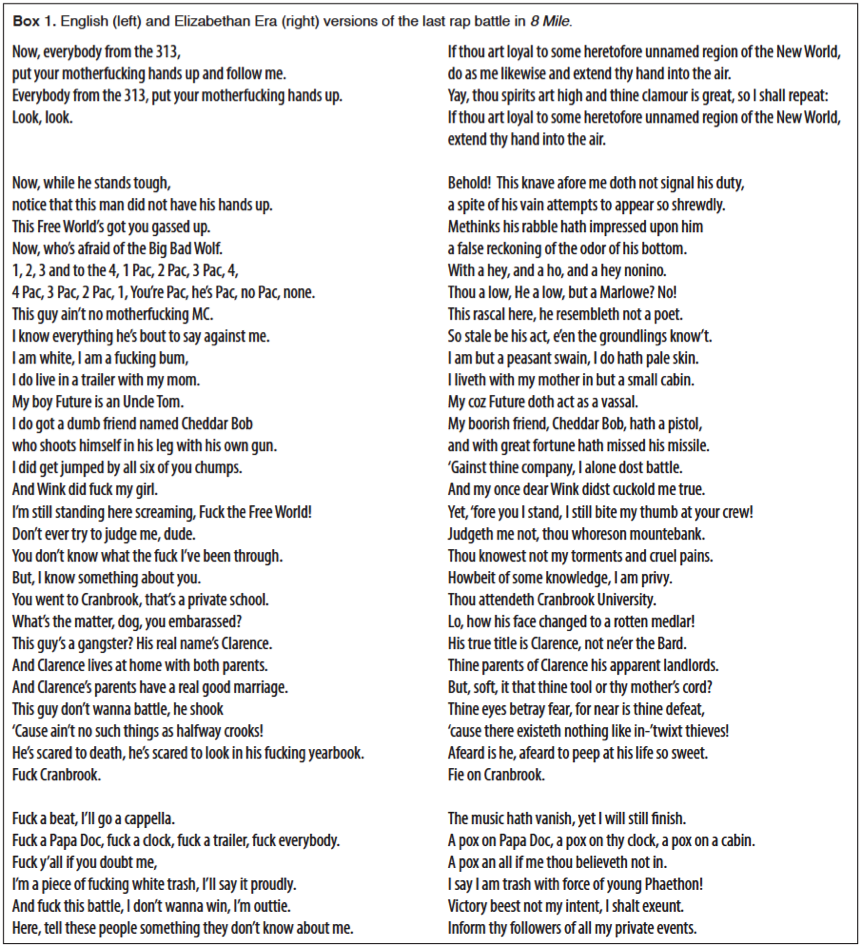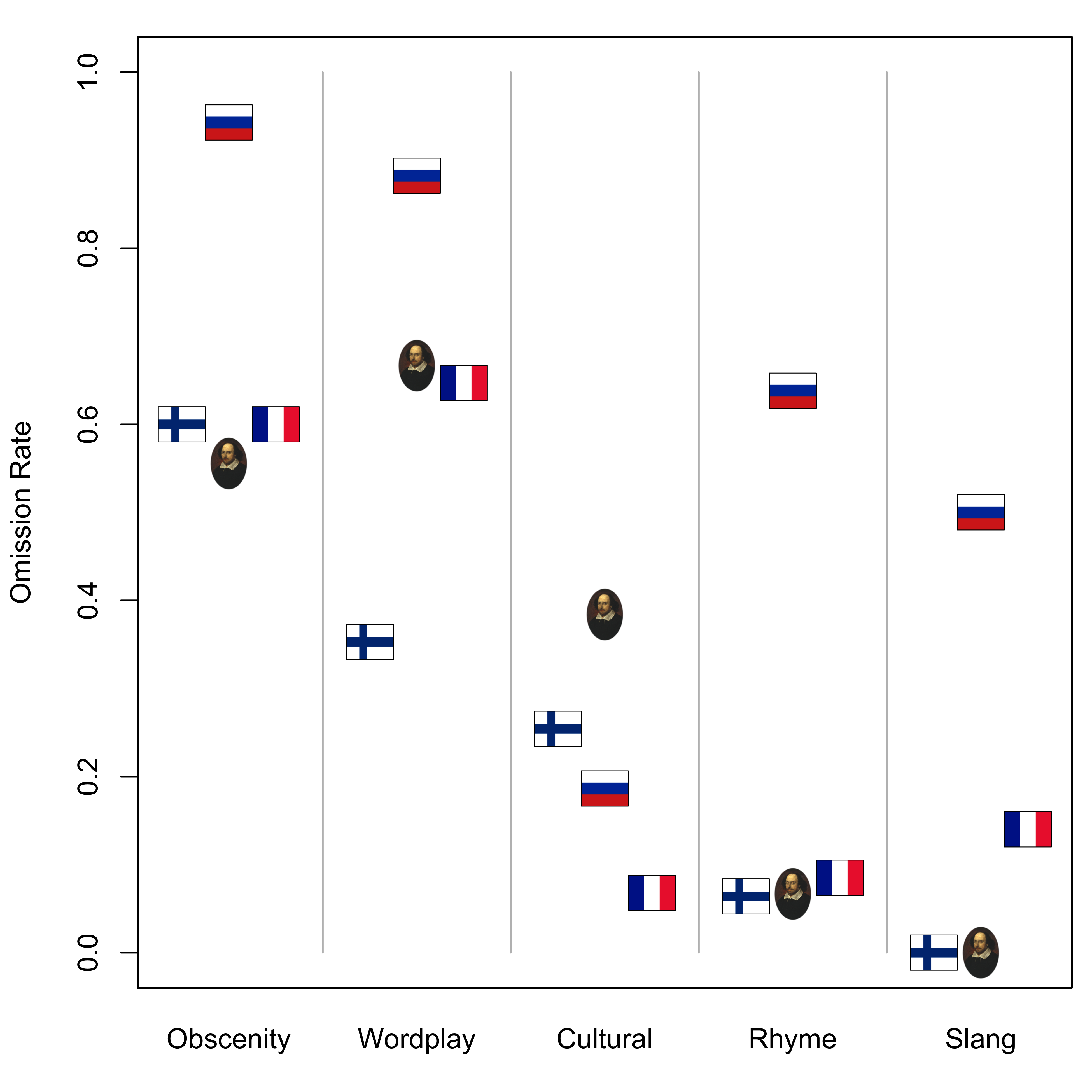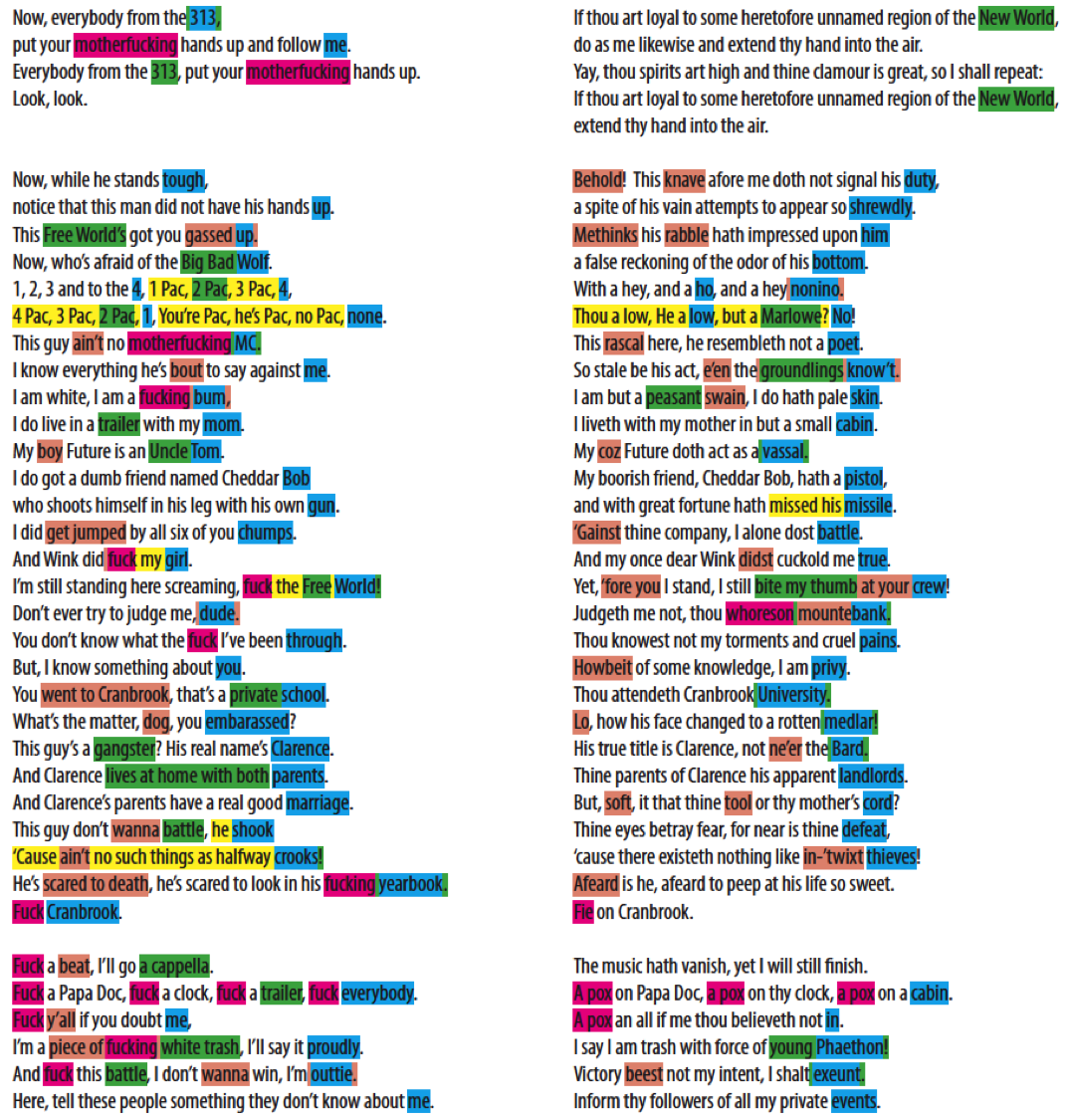
Tweet
September 12, 2014
Proceedings of the Natural Institute of Science | Volume 1 | HARD 2
A Shakespearean translation of the last rap battle in 8 Mile, with a subsequent analysis of its quality
Temporal Translators Alliance1 & Department of Quantitative Literature1
1 - PNIS

Introduction
The movie 8 Mile, which chronicles the rise of aspiring rapper Jimmy ‘B-Rabbit’ Smith (played by Eminem), has been translated into over 15 languages including Russian, Dutch and Japanese. Noticeably absent from this list is Elizabethan-Era English (EEE), the language used by William Shakespeare. From a commercial perspective, this omission is perfectly understandable, as there seems to be few native EEE speakers alive today. However, from an historical and academic perspective, this omission is unfortunate, as Shakespeare’s works have often been compared to rap lyrics (Brock 2009, Bradley and duBois 2011, Lars 2012, Akala 2012; click citations for links), and a recent analysis lists Shakespeare as having the 15th most unique vocabulary among rappers (Daniels 2014). Thus it would be interesting to see just how easily 8 Mile translates into EEE.
The goal of this paper is to jumpstart that translation of 8 Mile. We focus on the movie’s climax: B-Rabbit’s last rap battle with Papa Doc. In addition, we analyze the quality and fidelity of our translation using the methods of Taivalkoski-Shilov (2008), which we describe below.
Methods
Background – The climax of 8 Mile is a rap battle between B-Rabbit and members of the “Leaders of the Free World”. B-Rabbit faces off against three of these members in successive battles, but here we translate just the last battle against Papa Doc, the leader of the “Leaders of the Free World”.
Translation – There are no real set methods for translating, although we tried to keep true to the original meaning behind each rhyme complex. To help us in obtaining Shakespearean phrases and words, we read Hamlet and Romeo and Juliet (i.e., watched the movies). The website Shakespeare’s Words was also an enormous help.
Quality Analysis – Taivalkoski-Shilov (2008) assessed the quality and fidelity of three 8 Mile translations (Finnish, French, and Russian) by using 5 different criteria:
1. Obscenity – you know what these are (sfw example: “ass”).
2. Wordplay – anytime a pun is used, or any play on words (e.g., Hamlet’s first words after his Uncle refers to him as his son: “A little more than kin and less than kind” 1.2.65).
3. Cultural references – References to the culture of the time period in which the piece is written (an example for B-Rabbit could be ‘313’, a reference the area code for a Detroit neighborhood; an example for Shakespeare might be ‘The New World’, a reference to America).
4. Rhyme – We were only interested in end rhymes. We also accepted imperfect rhymes (e.g., suspicious/bitches) as well as perfect rhymes.
5. Slang/Colloquialism – Mostly refers to language below standard educated speech, or language that is common for that time period (an example for B-Rabbit could be ‘gonna’; an example for Shakespeare could be ‘methinks’).
Following the methods of Taivalkoski-Shilov (2008), we first analyzed each rhyme complex of B-Rabbit’s lyrics and counted whenever one of the five criteria above was used. We then analyzed our own translation for the same criteria. In the end, we calculated an ‘omission rate’ which describes the proportion of the translated rhyme complexes that lacked a certain criteria (i.e., an omission rate of 0.0 for Obscenity means that the translation included a swear word whenever B-Rabbit had a swear word). It is also important to note that our translation was not biased by these criteria (we created our translation before we came across Taivalkoski-Shilov’s paper).
Results
Box 1 contains both B-Rabbit’s lyrics (obtained from rapgenius) and our EEE translation. We’ve also highlighted the instances of each of the five criteria below in the Appendix. These, we realize, are fully open to opinion.

Our omission rates for each criteria are given in Fig. 1. For comparison, we also plot the omission rates for the Finnish, French, and Russian translations, obtained from Taivalkoski-Shilov (2008).

Discussion
Fig.1 shows that we performed the best in mimicking the Slang and Rhyme of B-Rabbit’s original lyrics. Shakespeare is known for creating many common words and phrases (like ‘obscene’), so it’s not much of a surprise that we were able to translate much of the slang (in fact, some of B-Rabbit’s slang words originated with Shakespeare).
In comparison with the other 4 translations, we were the 3rd most faithful overall. Apparently, our translators are experts in Shakespearean swear words, as we were the best performer in the Obscenity criteria. Our translation was the worst in Culture-Specific references, so we apologize for not being experts in Elizabethan-Era culture.
Overall, though, we were able to show that an EEE translation of 8 Mile is very possible, especially for the complicated rap-battle scenes. Unfortunately, there really isn’t a market for such a translation, which makes this paper much ado about nothing (although that was a foregone conclusion...). Good night, sweet Prince!
References
Akala. 2012. Hip-Hop & Shakespeare? TEDxAldeburgh. January 27.
Bradley A, DuBois A, eds. 2011. The Anthology of Rap. Yale University Press.
Brock CR. 2009. Comparing Shakespeare to modern rap or poetry. Humanities 360. November 15.
Daniels M. 2014. The largest vocabulary in Hip Hop. May.
Lars MC. 2012. The Hip-Hop of Shakespeare. RapGenius.
Taivalkoski-Shilov K. 2008. Subtitling 8 Mile in three languages: Translation problems and translator licence. Target 20:249-274.
Appendix
English (left) and Elizabethan Era (right) versions of the last rap battle in 8 Mile, with color-coding denoting instances of one of five criteria: Obscenity (red), Wordplay (yellow), Cultural Reference (green), Rhyme (blue), and Slang/Colloquialism (orange).


Proceedings of the Natural Institute of Science (PNIS) by https://instsci.org/ is licensed under a Creative Commons Attribution-ShareAlike 4.0 International License.